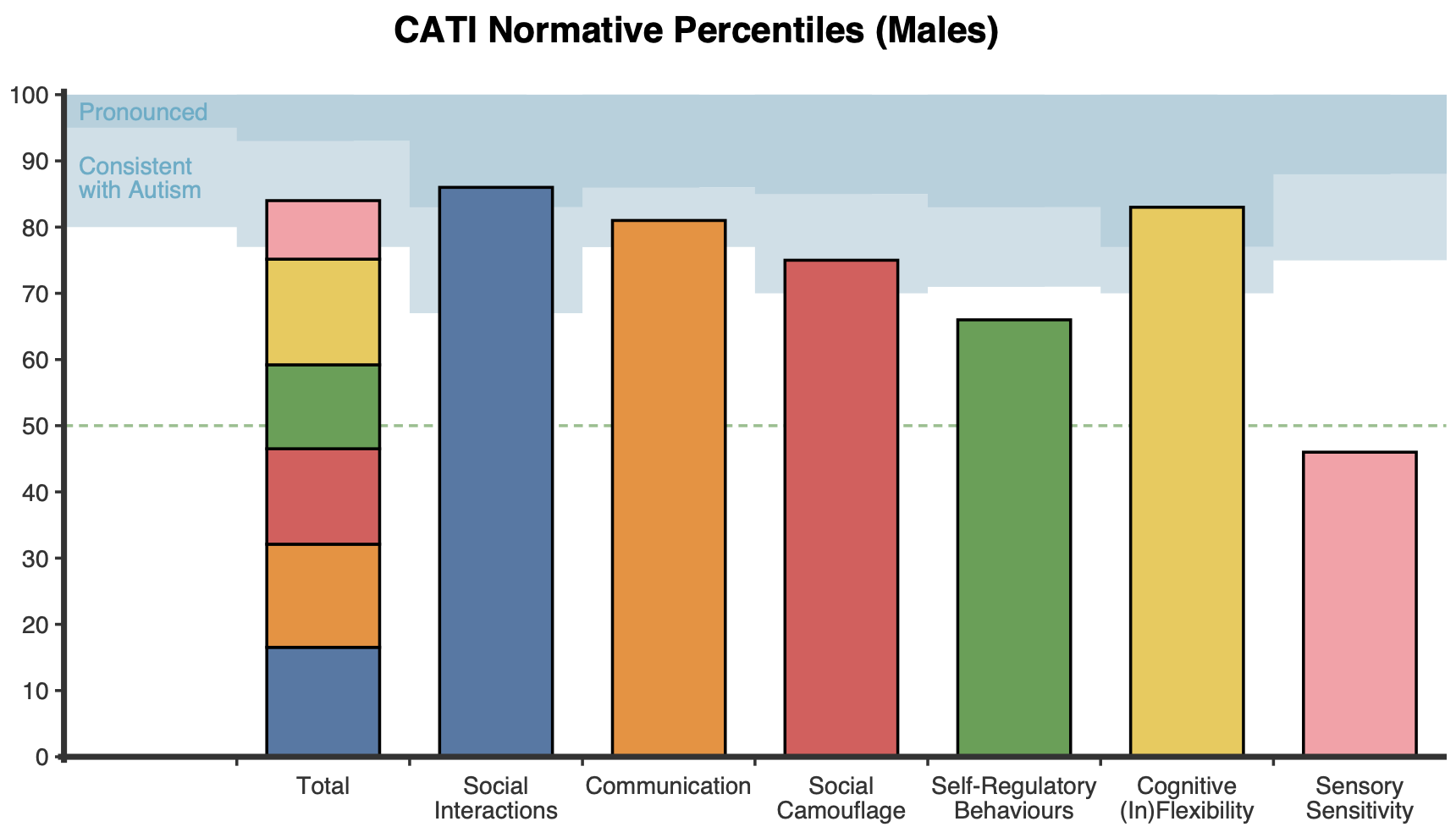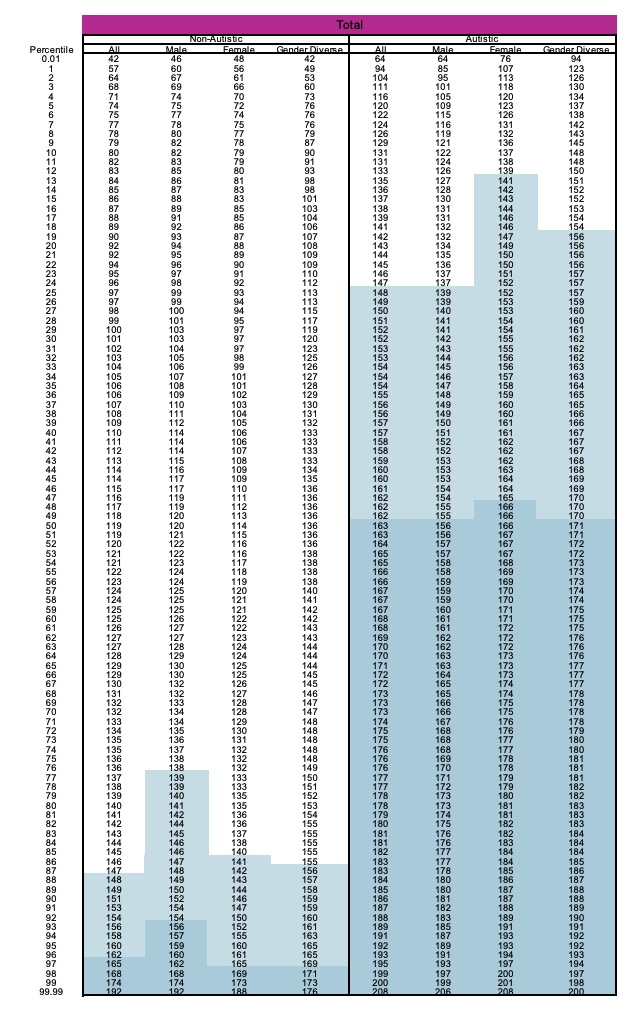The Comprehensive Autistic Trait Inventory (CATI) is a 42-item self-report questionnaire designed to assess traits and characteristics relevant for the identification of adults with Autism. The CATI was intentionally developed as a neurodiversity affirming questionnaire.
As a neurodiversity affirming questionnaire, the CATI (English et al., 2021, 2024) addresses limitations of existing measures by incorporating a broader range of autistic traits, consulting directly with Autistic individuals on the content and wording of items, and having an Autistic researcher on the team.
It can be used by a qualified professional, such as a psychologist, as part of a comprehensive assessment process for Autism.
The CATI has six subscales:
A key strength of the CATI, compared to other measures of autistic traits such as the Autism-Spectrum Quotient (AQ) is its inclusion of sensory sensitivity and social camouflaging, aligning with the growing recognition and understanding of Autism’s diverse presentation, particularly among women and gender diverse people.
Research has demonstrated that Autistic and Non-Autistic adults show different score profiles on the CATI across all subscales (English et al., 2024). The CATI has been validated in diverse populations, including people of varying genders and ages.
Like other measures of autistic traits, the CATI should not be solely relied upon for assigning an Autism diagnosis, and consideration should be made as to whether CATI scores may reflect phenomena other than, or co-occurring with, Autism (e.g., people with social anxiety may show elevated Social Interactions subscale scores).
Comprehensive Autistic Trait Inventory (CATI) scores are presented as a total scale score as well as scores on six subscales. Higher scores are indicative of more traits and characteristics associated with Autism.

The client’s total and subscale scores are expressed as percentiles based on normative data for Non-Autistic adults of the same gender (e.g., male, female, or gender diverse) (English et al., 2024). The percentiles contextualise the client’s scores relative to the typical scores of Non-Autistic adults. For example, the 50th percentile represents the typical levels of autistic traits among Non-Autistic adults, while scores on the 90th percentile fall within the top 10% when compared to Non-Autistic adults. Scores in this higher range are more consistent with those of Autistic adults than Non-Autistic adults.

A score is classified as “Consistent with Autism” if it more closely resembles the scores of Autistic adults of the same gender than those of Non-Autistic adults. A score is considered “Pronounced” if it is in the upper half of the Autistic distribution, reflecting higher levels of autistic traits.
Scores classified as either “Consistent with Autism” or “Pronounced” suggest that the client exhibits autistic traits at a level consistent with Autistic adults of the same gender. Gender-specific distributions of scores, and their classifications, among Autistic and Non-Autistic adults are presented in the supplementary materials.
The total scale score reliably distinguishes between Non-Autistic and Autistic people, with cut-off scores calculated through statistical analyses that maximise the chances of correctly classifying Autistic people as Autistic and minimise the chances of incorrectly classifying Non-Autistic people as Autistic (English et al., 2024). The total scale cut-off scores are as follows.
It is important to acknowledge that the differing gender-specific cut-off scores may reflect systemic factors, including biases in referral and assessment processes, as well as gender differences in the presentation of Autism and likelihood of diagnostic overshadowing. The higher cut-off scores for gender diverse individuals and cisgender females, in particular, may stem from historical underdiagnosis within these groups. The cut-off scores reflect current diagnostic criteria and practices and are subject to change as the understanding, characterisation, and assessment of Autism continue to evolve.
Graphs comparing the total and subscale scores to the normative distribution of scores among Non-Autistic and Autistic adults are presented, with shaded areas corresponding to scores between the 25th and 75th percentile. These graphs contextualise the client’s scores relative to typical levels of autistic traits among Non-Autistic and Autistic adults.

The CATI can be used by a qualified professional, such as a psychologist, as a preliminary screener during a comprehensive assessment process for Autism.
The Comprehensive Autistic Trait Inventory (CATI) demonstrates robust psychometric properties, with strong reliability and validity for assessing autistic traits.
Developed through exploratory factor analysis, the CATI consists of 42 items across six subscales: Social Interactions, Communication, Social Camouflage, Self-Regulatory Behaviours, Cognitive (In)Flexibility, and Sensory Sensitivity (English et al., 2021). Confirmatory factor analysis (CFA) supported this six-factor structure in both the general population (English et al., 2021) and a large, age- and gender-diverse sample of Autistic and Non-Autistic adults (English et al., 2024), indicating that the CATI adequately captures key autistic traits.
The CATI has been found to outperform both the Autism-Spectrum Quotient (AQ) and Broad Autism Phenotype Questionnaire (BAPQ) for classifying Autistic and Non-Autistic people (English et al., 2021).
The CATI demonstrates high internal consistency, with Cronbach’s alpha values of 0.969 for the total scale and between 0.855 and 0.941 for the subscales, reflecting reliable measurement of related traits within each factor (English et al., 2024).
Evidence for construct, convergent, criterion, and discriminant validity includes the following:
Importantly, measurement invariance has been established across Autistic and Non-Autistic groups and across genders, confirming that the CATI can be used to make meaningful comparisons between these populations.
The CATI was validated on a large, age- and gender-diverse sample of 1,322 Autistic and 1,279 Non-Autistic adults (mean age = 36.1 years, SD = 11.8 years), allowing for meaningful interpretation of a client’s total score and subscale scores relative to both Autistic and Non-Autistic adults of the same gender.

Percentiles and corresponding CATI total and subscale scores are presented here. Percentiles indicate the percentage of people in the normative sample who scored the same as or lower than a given score. For example, a total score of 146 corresponds to the 84th percentile in the normative sample of Non-Autistic males, indicating that 84% of that sample have a total score of 146 or lower. The same total score (i.e., 146) corresponds to the 34th percentile in the normative sample of Autistic males, indicating that 34% of that sample have a total score of 146 or lower. Scores classified as “Consistent with Autism,” which are coloured lighter blue, more closely resemble the scores of Autistic adults than those of Non-Autistic adults. Scores classified as “Pronounced,” which are coloured darker blue, are in the upper half of the Autistic distribution, reflecting higher levels of autistic traits.
English, M. C. W., Gignac, G. E., Visser, T. A. W., Whitehouse, A. J. O., Enns, J. T., & Maybery, M. T. (2021). The Comprehensive Autistic Trait Inventory (CATI): Development and validation of a new measure of autistic traits in the general population. Molecular Autism, 12(1), 37. https://doi.org/10.1186/s13229-021-00445-7
See https://www.cati-autism.com/ for additional information on the CATI, including updates, PDF-format forms, and translations.
English, M. C. W., Gignac, G. E., Visser, T. A. W., Whitehouse, A. J. O., Enns, J. T., & Maybery, M. T. (2021). The Comprehensive Autistic Trait Inventory (CATI): Development and validation of a new measure of autistic traits in the general population. Molecular Autism, 12(1), 37. https://doi.org/10.1186/s13229-021-00445-7
English, M., Poulsen, R., Maybery, M., McAlpine, D., Sowman, P. F., & Pellicano, L. (2024, June 14). Psychometric evaluation of the Comprehensive Autistic Trait Inventory (CATI) in autistic and non-autistic adults. Retrieved from https://doi.org/10.31234/osf.io/gfaeq
NovoPsych’s mission is to help mental health services use psychometric science to improve client outcomes.
© 2023 Copyright – NovoPsych – All rights reserved